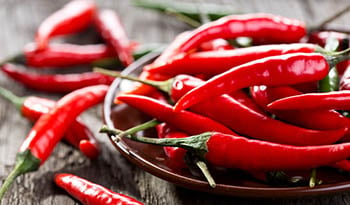Cayenne Pepper—5 Health Benefits + How to Get More in Your Diet
DISCLAIMER:This blog does not intend to provide diagnosis...
- In this article:
- What Is Cayenne Pepper?
- Cayenne Pepper Nutrition
- Cayenne Pepper Health Benefits
- Ways to Add Cayenne Pepper to Your Diet
- How to Eat Cayenne Pepper
- Cayenne Lemon Water Tonic Recipe
- Who Should Not Eat Cayenne Pepper
- Takeaway

What Is Cayenne Pepper?
Cayenne peppers grow on a bush and have red, rippled skin. While often considered vegetables, they are more accurately classified as fruits because they contain seeds. Cayenne peppers are types of Capsicum annuum, like bell peppers, which are flowering plants in the nightshade family. They get their name from their origin city, Cayenne, French Guiana.
Cayenne peppers can reach between 4 to 10 inches long. They grow best in moist soil in warm, sunny climates where the temperature is between 70 to 84 degrees Fahrenheit.
Cayenne peppers owe their fiery flavor profile to a compound known as capsaicin and are often used in culinary dishes to boost spice. Cayenne powder, also used for culinary purposes, is made from a blend of different types of dried chili peppers.
Cayenne Pepper Nutrition
As a source of fiber and vitamins C, A, B6, and K, cayenne pepper offers many nutritional benefits. In fact, one red hot chili pepper has 72% of the Daily Value (DV) of vitamin C, 48% DV of vitamin A, 13% DV of vitamin B6, and 5% DV of vitamin K. Cayenne peppers also contain the powerful plant compounds flavonoids and carotenoids and the minerals potassium, magnesium, and zinc.
- Vitamin A: important for vision, reproductive health, and immune system health and supports the health and function of the heart, lungs, kidneys, and other organs
- Vitamin C: a powerful antioxidant that supports immune health and collagen production and helps protect cells against the damaging effects of free radicals
- Vitamin B6: also known as pyridoxine, vitamin B6 is necessary for both nervous and immune system health
- Vitamin K: essential for blood clotting and supports bone health
- Potassium: works to support healthy fluid levels within the cells and supports muscle contraction and normal blood pressure levels
- Magnesium: acts as a natural muscle relaxant and supports nerve and bone health and healthy blood sugar levels
- Zinc: an important mineral for supporting immune system health, wound healing, and growth and development
- Flavonoids and carotenoids: can help reduce the harmful effects of free radicals and oxidative stress
A diet high in antioxidant-rich plant-based foods like cayenne peppers may help reduce the risk of diet-related diseases, including diabetes, cardiovascular disease, and chronic disease.1
Cayenne Pepper Health Benefits
Cayenne peppers get their spicy flavor from capsaicin, a compound responsible for many of cayenne peppers’ health benefits.
1. May Reduce Pain and Boost Athletic Performance
Eating cayenne pepper or taking cayenne supplements is associated with reduced pain, improved athletic performance, and lower blood sugar levels.2,3
2. May Reduce Inflammation
While cayenne pepper may turn up the heat in a recipe, it actually has anti-inflammatory properties. The capsaicin in cayenne peppers can support blood circulation, helping bring nutrients to organs and tissues.
3. May Support Weight Management
Consuming cayenne pepper may help manage blood sugar and temporarily increase metabolism. In one small study, women who consumed 5 grams of chili pepper experienced a smaller rise in blood sugar and had a higher metabolic rate for 30 minutes after drinking a sweetened beverage.5 A fast metabolism burns calories more quickly, which may support weight loss. Cayenne’s impact on metabolism is attributed to the compounds capsaicin and dihydrocapsiate.
4. May Support Heart Health
Cayenne pepper may support cardiovascular health, help strengthen the circulatory system, and support healthy arteries, capillaries, and nerves. A review of the effect of capsaicin on the cardiovascular system found that chili pepper-rich diets are associated with a reduced risk of dying from cardiovascular disease. However, the mechanism isn’t fully understood.6
5. May Improve Gut Health
Cayenne peppers or cayenne powder can help stimulate the digestive system, helping improve bowel regularity. As a plant-based food, cayenne peppers can also support microbial diversity in the gut.
Cayenne peppers and other plant-based foods are rich in fiber. When bacteria in the gut digest high-fiber foods, they produce short-chain fatty acids. These short-chain fatty acids offer anti-inflammatory, immunoregulatory, anti-obesity, anti-diabetes, cardiovascular protective, hepatoprotective, and neuroprotective qualities.7
Ways to Add Cayenne Pepper to Your Diet
There are many ways to up the spice and health benefits of the foods you eat with cayenne peppers or cayenne powder. Try these ideas to eat more cayenne pepper!
- Add a pinch of cayenne powder to soups, sauces, or stews
- Sprinkle over protein, such as eggs, salmon, or chicken
- Add to hummus
- Add to sautéed vegetable dishes
- Add to cornbread
- Add a pinch to hot chocolate
- Add a pinch to lemonade or lemon water
- Use in homemade dressings or marinades
- Add cayenne pepper to homemade roasted, mixed nut mix
- Add cayenne pepper to grain dishes like rice or quinoa
How to Eat Cayenne Pepper
There’s no wrong way to eat cayenne pepper—enjoy it raw, cooked, or dried into a powdered form. Cayenne pepper is also available in capsules for medicinal purposes as approved by your doctor.
Want to grow your own cayenne peppers? Ensure you wear gloves when you harvest them so the irritating oils of the peppers don’t accidentally get into your eyes or any cuts on your skin. Also, be sure to harvest the peppers before they become too soft. Pick them when they are still firm and require a little tug to separate from the plant.
To dry cayenne peppers, hang them on a clothesline in a dry area about 3 inches apart. They should be ready to use in about a week. Once dried, you can coarsely grind the peppers in a food processor to produce red chili flakes, such as the ones used on pizza, or grind them into a powder for use in cooking.
You can use fresh cayenne peppers raw or cook them like a jalapeno—just keep in mind that cayennes are about 10 times hotter than jalapenos. If you love heat in your food, try using them in fresh salsa, chili, or cooked down into a hot sauce. Remember, when working with fresh cayenne peppers, do not touch your eyes, and wash your hands often.
For a convenient way to enjoy the benefits of cayenne pepper, buy ready-made cayenne powder or chili flakes.
Cayenne Lemon Water Tonic Recipe
Adding cayenne powder to a daily wellness tonic is a simple and effective way to enjoy the health benefits of cayenne peppers. Try this cayenne lemon water tonic below!
Makes 4 Servings
Ingredients:
- 16 ounces of filtered water
- 1 whole lemon, juiced
- ½ teaspoon cayenne powder
- 1 teaspoon raw honey (or more to desired taste)
Instructions:
Heat water on the stovetop or in a kettle. Add in fresh lemon juice and cayenne pepper and stir. Then add honey and stir to melt. Enjoy warm or chilled. Wait until the water has cooled a bit before adding the honey—adding honey to boiling water dampens honey’s health benefits. Store extra tonic in the refrigerator and drink within 5 days.
Who Should Not Eat Cayenne Pepper
While cayenne pepper and cayenne powder are notable for their flavor and health benefits, some individuals may not tolerate them well. People with irritable bowel syndrome (IBS), an ulcer, diverticulitis, asthma, or taking a blood thinner should use caution when consuming cayenne pepper or cayenne powder. Cayenne is spicy, so take care when handling the fruit or spice to avoid getting it in your eyes, which could burn or cause extreme irritation.
Takeaway
Cayenne pepper is a spicy, flavorful, and nutritious fruit that supports heart and gut health a healthy metabolism, and may help reduce inflammation. While cayenne pepper is not a cure-all superfood, incorporating it into a healthy diet and other healthy lifestyle habits supports short- and long-term health and gives your food a delightful kick.
References:
- Aune D, Keum NN, Giovannucci E, et al. Dietary intake and blood concentrations of antioxidants and the risk of cardiovascular disease, total cancer, and all-cause mortality: a systematic review and dose-response meta-analysis of prospective studies. Am J Clin Nutr. 2018;108(5):1069.
- McCarty MF, DiNicolantonio JJ, O’Keefe JH. Review: Capsaicin may have important potential for promoting vascular and metabolic health. Open Heart. 2015;2(1):e000262.
- de Freitas MC, Cholewa JM, Gobbo LA, de Oliveira JVNS, Lira FS, Rossi FE. Acute Capsaicin Supplementation Improves 1,500-m Running Time-Trial Performance and Rate of Perceived Exertion in Physically Active Adults. J Strength Cond Res. 2018;32(2):572-577.
- Yamani N, Musheer A, Gosain P, et al. Meta-analysis evaluating the impact of chili-pepper intake on all-cause and cardiovascular mortality: A systematic review. Ann Med Surg (Lond). 2021;70.
- Chaiyata P, Puttadechakum S, Komindr S. Effect of chili pepper (Capsicum frutescens) ingestion on plasma glucose response and metabolic rate in Thai women. J Med Assoc Thai. 2003;86(9):854-860.
- Szallasi A. Dietary Capsaicin: A Spicy Way to Improve Cardio-Metabolic Health? Biomolecules. 2022;12(12).
- Xiong RG, Zhou DD, Wu SX, et al. Health Benefits and Side Effects of Short-Chain Fatty Acids. Foods. 2022;11(18).

 By Megan Roosevelt, RDN
By Megan Roosevelt, RDN


